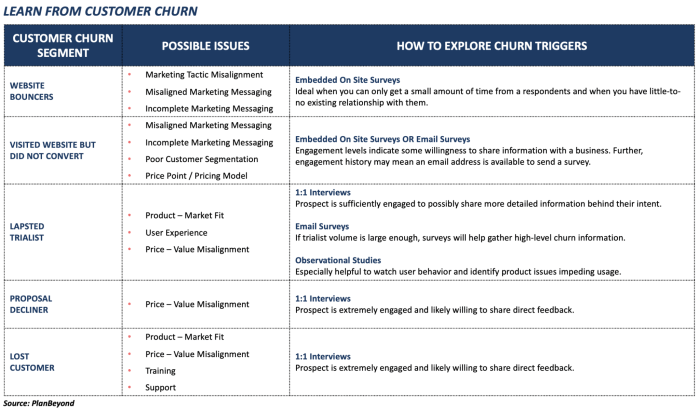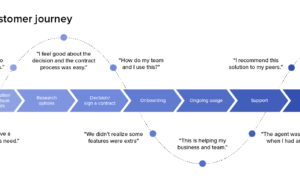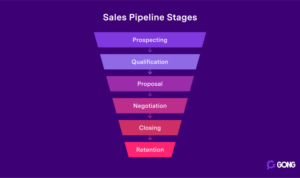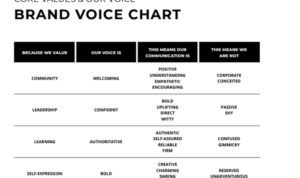Kicking off with Understanding Customer Churn, this topic delves into the dynamics of customer retention, exploring the factors and strategies that play a crucial role in business success. From analyzing customer behavior to implementing effective retention strategies, this discussion aims to provide valuable insights for companies looking to reduce churn rates and enhance customer loyalty.
Introduction to Customer Churn
Customer churn refers to the percentage of customers who stop using a company’s products or services during a certain time period. It is a crucial metric for businesses as it directly impacts revenue and profitability. Understanding customer churn is essential for companies to identify reasons why customers are leaving and to implement strategies to retain them.
Examples of Industries Heavily Impacted by Customer Churn
- Telecommunications: Telecom companies often face high customer churn rates due to intense competition and constantly changing technology.
- Subscription-based Services: Companies offering subscription services like streaming platforms or software subscriptions need to closely monitor customer churn to maintain a loyal customer base.
- Retail: In the retail industry, customer churn can occur due to factors such as poor customer service, pricing, or availability of products.
Factors Influencing Customer Churn
Customer churn is influenced by various factors that can impact a business’s bottom line. Understanding these factors is crucial in developing strategies to reduce churn rates and improve customer retention.
Customer Service Quality:
Providing excellent customer service can significantly reduce customer churn. Customers are more likely to stay loyal to a company that values their needs and resolves issues promptly. Poor customer service can lead to dissatisfaction and ultimately churn.
Pricing Strategies:
The pricing of products or services can also affect customer churn. Offering competitive prices or discounts can attract and retain customers. However, overly high prices or sudden price increases may drive customers away to competitors.
Competitor Actions:
Competitor actions play a significant role in customer churn. If competitors offer better products, services, or pricing, customers may be inclined to switch brands. Keeping an eye on competitor strategies and adjusting your own offerings can help prevent customer defection.
Impact of Customer Feedback
Customer feedback is a valuable tool in reducing churn rates. By actively listening to customer concerns and suggestions, businesses can address issues, improve products or services, and enhance overall customer satisfaction.
Analyzing Customer Behavior

Customer behavior analysis plays a crucial role in predicting churn and implementing effective retention strategies. By tracking customer actions, preferences, and feedback, businesses can gain valuable insights to reduce churn and improve customer satisfaction.
Methods for Tracking Customer Behavior
- Utilize customer relationship management (CRM) software to track interactions, purchase history, and communication with customers.
- Implement website analytics tools to monitor online behavior, such as page views, time spent on site, and click-through rates.
- Conduct surveys and gather feedback to understand customer sentiments, preferences, and pain points.
- Monitor social media engagement to gauge customer satisfaction, identify issues, and track sentiment towards the brand.
Importance of Data Analytics in Understanding Customer Preferences
Data analytics allows businesses to analyze large volumes of customer data to identify trends, patterns, and correlations. By leveraging data analytics tools, companies can gain insights into customer preferences, behavior, and needs, enabling them to personalize offerings and enhance customer experiences.
Utilizing Customer Feedback to Reduce Churn
Customer feedback is a valuable source of information that can help businesses understand customer expectations, satisfaction levels, and areas for improvement. By actively listening to customer feedback, addressing concerns, and implementing changes based on suggestions, companies can increase customer loyalty and reduce churn rates.
Examples of Successful Customer Behavior Analysis Strategies
- A subscription-based streaming service analyzes viewing habits to recommend personalized content, reducing churn by keeping customers engaged.
- An e-commerce platform tracks purchase history and browsing behavior to send targeted promotions, increasing customer retention and loyalty.
- A mobile app collects user feedback through in-app surveys to identify usability issues and enhance the overall user experience, leading to decreased churn rates.
Retention Strategies
Customer retention is crucial for the success of any business. Implementing effective strategies can help reduce customer churn and increase loyalty. Here are some key strategies to consider:
Personalized Marketing, Understanding Customer Churn
Personalized marketing involves tailoring your marketing efforts to meet the specific needs and preferences of individual customers. By analyzing customer data and behavior, businesses can create targeted campaigns that resonate with their audience. This personalized approach can help build stronger relationships with customers and increase retention rates.
Customer Loyalty Programs
Customer loyalty programs incentivize customers to continue doing business with a company by offering rewards, discounts, or exclusive benefits. These programs not only encourage repeat purchases but also foster a sense of loyalty and belonging among customers. By rewarding loyal customers, businesses can reduce churn and increase customer lifetime value.
Proactive Customer Engagement
Proactively engaging with customers can help prevent churn by addressing issues and concerns before they escalate. By providing excellent customer service, personalized communication, and valuable resources, businesses can build trust and loyalty with their customers. Taking a proactive approach to customer engagement shows customers that their needs are valued and can lead to long-term relationships.
Customer Churn Metrics: Understanding Customer Churn

In the world of business, tracking customer churn is crucial for understanding the health of your customer base. To effectively measure and analyze customer churn, several key metrics are commonly used.
Key Metrics Used to Measure Customer Churn
- Churn Rate: This metric calculates the percentage of customers who have stopped using your product or service over a specific period. It is calculated by dividing the number of customers lost during that period by the total number of customers at the beginning of the period.
- Churn Prediction: Using data analytics and machine learning, companies can predict which customers are at risk of churning based on their behavior and interactions with the business.
- Customer Lifetime Value (CLV): This metric represents the total revenue a business expects to earn from a customer throughout their relationship. Understanding CLV can help prioritize retention efforts and identify valuable customers worth retaining.
Significance of Customer Lifetime Value in Understanding Churn
Customer Lifetime Value plays a critical role in understanding churn because it provides a long-term perspective on the value each customer brings to the business. By comparing CLV to the cost of acquiring and retaining customers, companies can make informed decisions about where to focus their resources to reduce churn and maximize profitability.
Examples of Companies Using Churn Metrics for Decision-Making
- Netflix: The streaming giant analyzes viewing habits and engagement metrics to predict which customers are likely to churn. They then use this data to personalize recommendations and retention offers to keep customers engaged.
- Salesforce: This CRM platform uses customer data and engagement metrics to identify at-risk customers and proactively reach out with targeted marketing campaigns or personalized communication to prevent churn.





